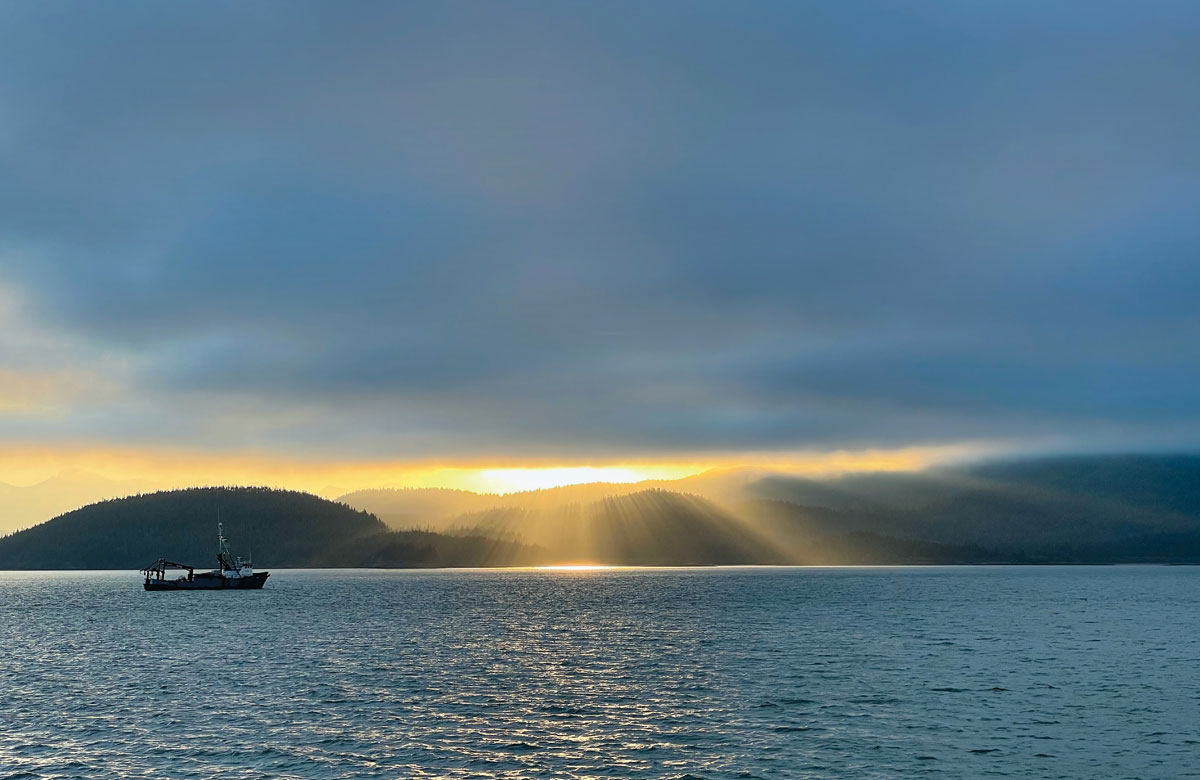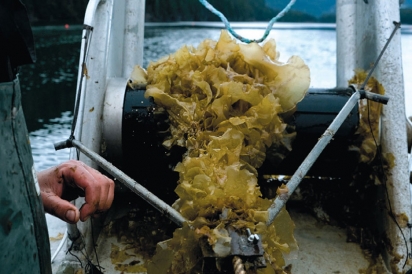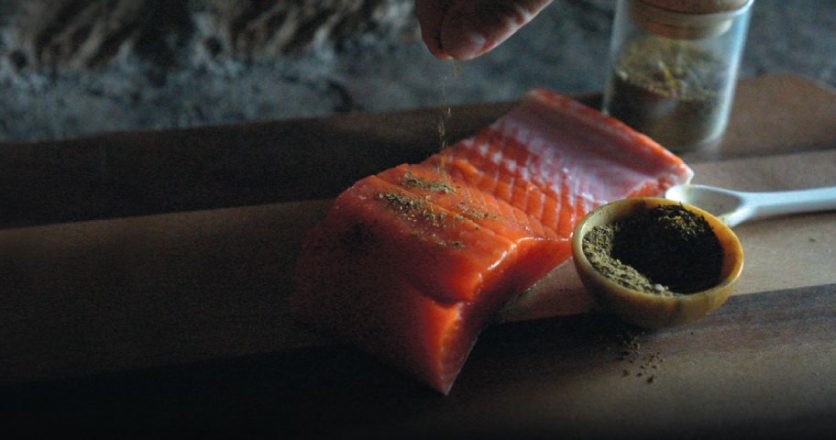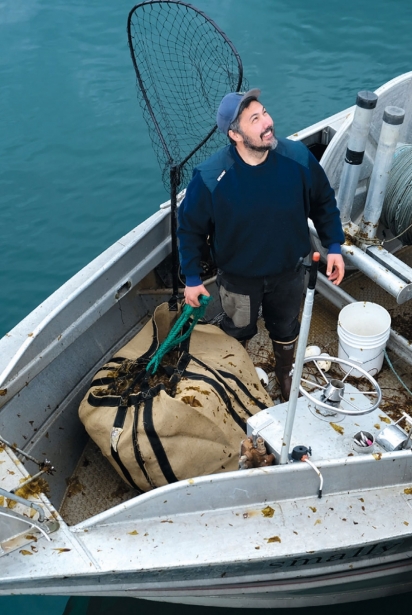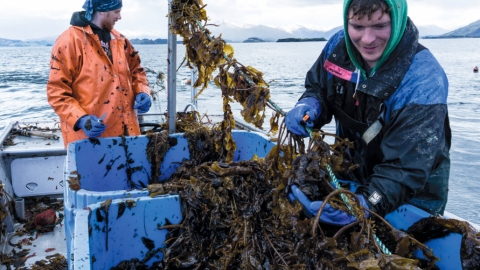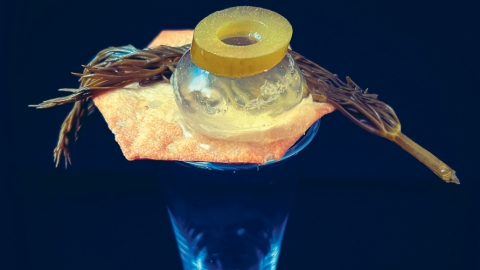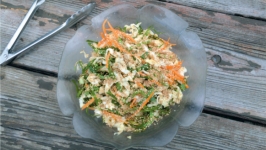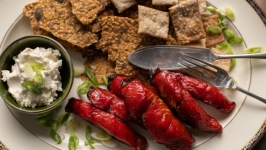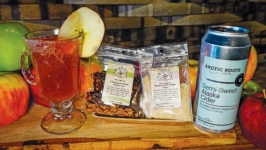Kelp Update
Editors’ Note: The National Oceanic and Atmospheric Administration (NOAA) defines mariculture as the culturing of shellfish and aquatic plant organisms such as seaweed in areas of the ocean close to shore. Since the 2019 Edible Alaska story on kelp farming, mariculture has experienced a surge in attention with funding, research, new farms, and associated services in many Alaskan coastal communities. This story revisits kelp farming, this time in the ancestral waters of the Eyak homelands around Cordova.
Ancestral waters: the ocean as home
Beneath the surface of the sea, sunlight filters downward, illuminating translucent curtains of golden-brown blades that sway gently in the cold clean waters near the Alaska coast. Wind and tides stir the surface overhead. All around, the world moves, a constant ebb and flow. Dense, tenacious tendrils called holdfasts anchor these wild kelp forests to the ocean floor. The living, undulating forests are home to a liquid universe teeming with life that includes microscopic plankton, shellfish, and other invertebrates, as well as fish and marine mammals.
Just as the lives of many water beings are interconnected within the realm of the kelp forests, the lives of people residing in Alaska’s coastal communities also are deeply intertwined with the vitality of the ocean. The ancestral homelands of dAXunhyuu, the Eyak people, encompass a magnificent territory of glaciated mountains, river deltas, and dense coastal forests of Southcentral Alaska between what is known today as the Copper River Delta and Prince William Sound. DAXunhyuu lifeways include a rich abundance of fish, game, berries, and other foods from the land and sea. These are disrupted by past and ongoing processes and systems of colonization—along with natural and human-caused disasters including the climate crisis and ensuing ocean acidification, which negatively impact the people.
The increased interest in and support of mariculture as a new industry for Alaska inspires reflections on the past and hopes for an economy that benefits all. “We have an opportunity to change the relationship with the land and the sea for the people who live in these frontline communities,” says Dune Lankard, Eyak fisherman, father, guide, and kelp farmer. Lankard is the founder of Native Conservancy, a non-profit organization based in Cordova that was established in 2003 “to empower Alaska Native peoples to permanently protect and preserve endangered habitats and their subsistence way of life on their ancestral homelands.” The holistic nature of his ocean farming work also involves building community resilience through regenerative economies, food sovereignty, and ocean stewardship. “During these rapidly climate changing times, we have to figure out how to change our relationship with our food sources, and with our ocean,” says Lankard. “This is an opportunity to create a blue-green regenerative economy to help communities along the coastline reinvent themselves and their changing ocean economies that are sensible, sustainable, regenerative and based on restoration, conservation and mitigation, not further extraction of our planet’s finite resources.” Also, Lankard emphasizes that seaweeds are ancestral foods that nourished coastal Indigenous peoples for generations long before mariculture came to these waters.
The current pace of growth in the mariculture field has heightened the need for caution and an honest examination of a colonial mindset to avoid repeating destructive patterns of the past. Jim Smith is an Eyak fisherman, father, and lifelong Cordova resident and director of Native Conservancy’s Reclaiming Land & Water Ties program. During the many pandemic challenges that included a fisheries downturn, Smith began employing his fishing and netmaking skills to design and build custom farm arrays for Native Conservancy. The perspective of Smith, a deep thinker who has been published on the subject of kelp, is a wise reminder of how today’s actions around kelp are critical in maintaining respectful relationships with the land and sea. “Kelp is a plant, waving around in the swell, doing what it’s been doing for millions of years,” he points out. “The problem is us. We can’t approach this the way it’s been approached before. You attach any type of monetary value on something, you will watch it get reallocated.” In his lifetime, Smith has seen the relationship people have with the land and water diminish. “The people that are from here and the animals and plants from here—our DNA has been living in tandem for thousands of years. That separation, that severed tie, means you quickly lose knowledge of what its life is like, in less than one generation.”
His program, Reclaiming Land & Water Ties, responds by harvesting and gifting traditional foods of the land and sea with Alaska Native elders in the community. With Native Conservancy staff already out on the water to check on farm sites, they take the time to also harvest, process, and distribute traditional foods that are in season. Marina Madison and other local chefs prepare the foods with love, and the staff delivers the frozen and cooked meals each month to the elders. “It connects [us] to each other and to the past. It brings up stories. It ties us to this place [where] we’ve been living for 10,000 years. It’s delivering nutritious food we are meant to eat,” says Smith. In this way, kelp’s role in restoring the ocean also involves restoring people’s connection to their foods.
Regenerative Economics of Restoration, Reciprocity, and Research
At first glance, kelp resembles land-based plants as an organism that is capable of photosynthesis and has similar structures such as a leaf-like blade, stem-like stalk, and root-like holdfast. Yet kelp and other seaweeds belong to the diverse Protista kingdom. Kelp is in the brown macroalgae grouping that includes the three species that are currently being cultivated by Alaskan kelp farmers: sugar kelp (Saccharina latissima), ribbon kelp (Alaria marginata), and bull kelp (Nereocystis luetkeana).
Kelp farming activities follow the life cycle of kelp throughout the year. Wild kelp forests are an essential source of seed for Alaska’s kelp farms. In the summer, farmers collect sorus—the reproductive tissue—from at least 50 wild kelp plants of the targeted species within 50 kilometers near the farm site. This is done to protect wild kelp ecosystems by ensuring that kelp farms grow genetic descendants of nearby wild kelp beds in a way that also maintains genetic diversity. The sori are taken to a hatchery to cultivate quantities of kelp seedlings in a controlled environment. The outplanting process brings the seedlings to the farm site where lines in the water are held in place with buoys and anchors. This collection and design of all this gear for the farm site is called an array. Outplanting in the fall involves attaching strings seeded with baby kelp to the farm site lines. Farmers visit their sites throughout winter and spring to monitor them until harvest time in late spring, generally before the busy fishing season. To begin the cycle again, farmers return to wild kelp beds to collect seeds for a new winter growing season.
Kelp farm sites in Alaska are permitted for research or for commercial purposes. Native Conservancy’s OceanBack program runs several research sites and a commercial site. Over the years, the team has gained experience with all aspects of setting up a kelp farm. “I didn’t know anything about kelp farming until three years ago,” recalls Tyler Quales, who was born and raised in Cordova. After finding himself without work due to the beginning of the COVID-19 pandemic, lifelong friends connected him with Native Conservancy’s kelp program. Today, he is familiar with a variety of kelp-related activities, including scientific monitoring of the sites. “As a new industry in a fishing town, what could be more perfect than something you already have the equipment for and know-how?” he says. “I haven’t fished for a decade but I know how to be on a boat and be safe. And you keep learning something new all the time.”
The crew works on a variety of activities throughout the year, such as going out on the water to monitor sites and collect scientific readings, diving to get seed, propagating kelp spores in the hatchery, building arrays, harvesting, processing, and working with the Reclaiming Land & Water Ties initiative. Once harvesting season is done, the crew works on maintenance of existing arrays and building new ones if needed. For array-building, Quales joins fellow OceanBack crew Grafton Schikora and Jesse MacDonald in a covered area shared with fishermen working on their nets. Seemingly endless lengths of lines stretch across the floor as they tie knots and splice line.
Similar to Quales, life changes led Schikora to kelp. After his son was born, Schikora knew he did not want to continue crab fishing, which took him away from home for months each season. Native Conservancy’s mariculture program allowed him to stay in the community, work on the water, and also gain a variety of new skills and experiences. He became a certified diver to collect seed and became a licensed boat captain. Working with kelp has also expanded his knowledge and experience of the ocean. “Imagine your whole life out on the water. You can see all the beautiful scenery on the surface,” he says. “After diving around here, it changes how you look at a bay. I have a mental picture of what’s going on underneath. I know the geography of this whole cliffside, where mounds on the ocean floor are and forests of anemones.”
OceanBack director Tesia Bobrycki who leads technical and scientific operations related to Native Conservancy’s farm sites, affirms how mariculture has provided each team member an opportunity to deepen their relationship with the ocean by learning to dive underwater and also monitor sites year-round including winter when few people are out on the water. “Building a relationship is seeing and experiencing it in all its multi-varied forms,” reflects Bobrycki. “It’s seeing things under the surface and in a different season. Seaweed has provided each of our team members [a way] to develop their own relationship with the ocean on a personal level,” she shares. “And it has provided a sense of stability in which they can dream and think about their future and take pride in what they do.”
In addition to Native Conservancy’s research sites, the Department of Environment and Natural Resources (DENR) at the Native Village of Eyak (NVE) operates a kelp farm for research. “We are interested in ecosystems services, so we are leaving most of our kelp in the water,” says Caitlin McKinstry, a biologist who manages the program. Since October 2022, McKinstry’s team has been monitoring and observing kelp growing at the site to learn about ocean acidification, carbon sequestration, and other potential ecological impacts of mariculture. McKinstry shares an exciting finding when visiting the farm on a calm day. “The water was flat, like a pond,” she describes. “We looked down and noticed ripples. Little larval fish. We were watching our kelp farm be habitat.” Kelp sites like NVE’s empower communities to learn and ask questions about the long-term effects of the farms on wild ecosystems along Alaska’s coastlines.
McKinstry also emphasizes that research and commercial farms fulfill different roles in mariculture, and she commends local commercial farmers’ efforts to grow food, develop processing techniques and markets. She highlights how all the Cordova kelp farmers work together. “Everybody has a very open and collaborative spirit,” she observes. “When people go check their farm, they check other farms. “We’re all trying to help each other.
Respect and Collaboration
Skye Steritz and her partner Sean Den Adel founded Noble Ocean Farms several years ago. A lifelong passion for the ocean led Steritz to professionally study in various fields that connected her to the sea, from sustainable fisheries to water policy. “I was lucky to be raised by parents who cultivated this love of the water, so at a young age I felt at home in the ocean,” she says. “With kelp farming, it’s important to get people involved who do have a sensitivity and respect for how it’s done.” As a commercial kelp farmer, being aware and careful about impacts is important. “You’re as responsible as you can be because of the other beings that are there, and you love the water itself.” Steritz credits Native Conservancy for helping them get started and sharing information and research. “Last year they helped us harvest our farm when our boat wasn’t working.” In small communities, camaraderie and partnership are essential.
She says that one of her favorite things about kelp farming is selling fresh, raw kelp to people right on the dock. Being able to sell most of her product locally to residents, restaurants, and companies outside requires long hours of marketing and outreach. When she and her partner are not working their full-time jobs, they are engaged in all aspects of the farm, from planting to harvesting, processing to marketing. The journey has been both exciting and exhausting. In addition to education and outreach of kelp products to an audience sometimes unfamiliar with its uses, Steritz emphasizes the challenges of processing infrastructure. “We are hand blanching and hand processing, the two of us.”
Royal Ocean Kelp Co. is another commercial kelp farm in Cordova growing sugar and ribbon kelp and jointly run by local seiner Cael Herschleb, his wife Catherine, and gillnetter Thea Thomas. “We planted first in 2021, harvested in spring 2022,” says Herschleb. “This past winter, we doubled the number of lines and area and grew twice as much kelp.” Handling the yield of thousands of pounds of sugar and ribbon kelp was a daunting task for the three-person team to harvest and process by hand. “We handle every blade of kelp, lay it in a fish box, and ship it down to the customer same day.” Their kelp is sold to Daybreak Seaweed Co., a California-based seasonings company. Juggling other work commitments, these two commercial kelp farms share in the challenges of starting up their businesses and figuring out marketing and more efficient processing operations.
Ancestral Nourishing Waters
For Alaska Native peoples and many coastal cultures around the world, seaweeds have long been used as food, medicine, and material for generations. Herring roe on kelp is one example of a much beloved traditional food.
Commercially-grown kelp is used for a variety of products such as cosmetics, plastics and packaging, compost and fertilizer. Yet the Cordova kelp farmers agree that the greatest use of kelp is culinary. “This is high quality kelp, from a clean marine environment, grown by small family farms, and operating on regenerative principles,” notes Steritz. Noble Ocean Farms sells fresh sugar kelp direct to customers, along with blanched frozen packages and canned kelp salsa that yields a mellow yet ocean-forward flavor and a smooth texture. Herschleb shares that his family dries and mills kelp to use in the kitchen like sea salt. “Sugar kelp has a mild, ocean breeze flavor that’s not fishy and goes well with garlic and earthy vegetables,” he describes. A new family favorite recipe is cabbage slaw with kelp flakes. “Ribbon is a third of the size of sugar kelp and has a really nice flavor. Fresh, it reminds me of black olives or artichoke. When dried, it has a toasty flavor.” As more kelp is being grown by Alaskan farmers for food, home cooks and professional chefs play a role in creating unique dishes and products or revitalizing local and global food traditions.
At Native Conservancy, land and sea meld together in smoky perfection as OceanBack program coordinator Brandyn Comparan delicately dusts a gleaming ruby-colored Copper River sockeye with smoked sugar kelp. “The smoked kelp is truly a representation of all the hard work and love put in by our OceanBack team,” says Comparan. “Smoking salmon is a traditional method of preserving salmon that has been practiced by Alaska Natives for centuries,” she explains. “We learned the art form from two beloved elders known as ‘smoke masters,’ who guided us technically and spiritually through the whole smoking seaweed endeavor.” The team hopes that this co-creation that draws on ancestral knowledge will spark inspiration for the many ways this gift from the sea could benefit people and planet and serve as a reminder to nourish a respectful relationship with the ocean and the ancestral homelands of dAXunhyuu.


